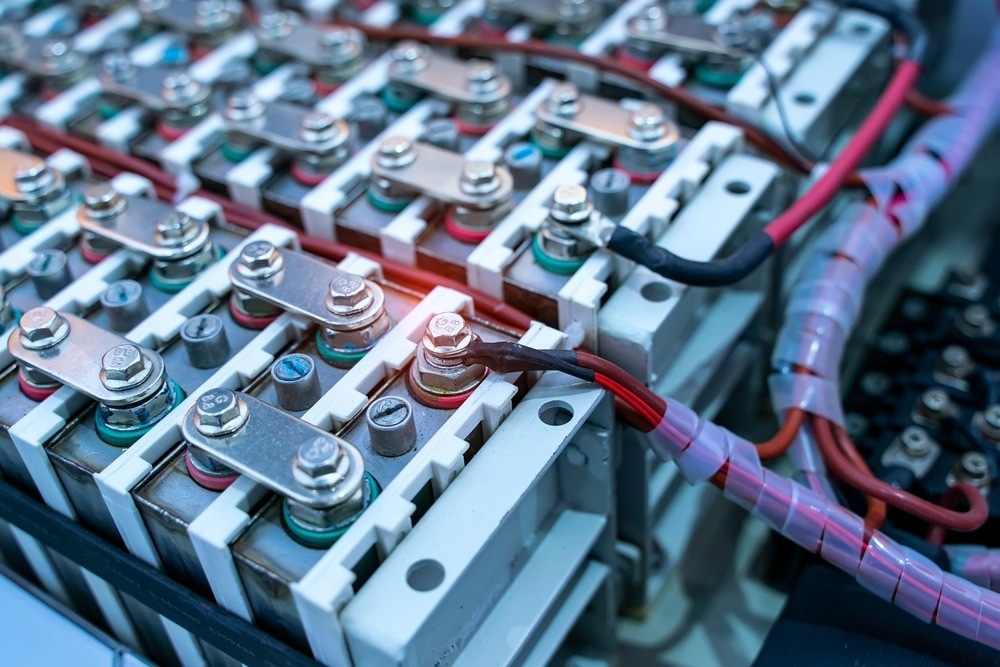Reviewed by Alex SmithDec 1 2022
Lithium-ion (Li-ion) batteries with high energy density are essential for powering electric and hybrid vehicles, next-generation devices, and power grids. These Li-ion batteries have transition metal oxide cathodes with high energy density.

Image Credit: asharkyu/Shutterstock.com
The LiNi1/3Mn1/3Co1/3O2 cathode has been proven to give the greatest performance at a high potential of 4.5 V vs. Li/Li+ with high reversible capacity among various examined promising materials.
Ethylene carbonate and diethyl carbonate, the carbonate species found in commercial electrolytes, however, experience severe oxidative decomposition at such high potentials. As a result, a thick cathode electrolyte interphase (CEI) layer accumulates on the cathode surface, substantially affecting its performance.
To prevent performance loss, researchers have looked into electrolyte additives that might stabilize and conceal the cathode surface. However, the current solutions involve safety and environmental risks.
A group led by Professor Noriyoshi Matsumi of Japan Advanced Institute of Science and Technology (JAIST) microbially synthesized 2,5-dimethyl-3,6-bis(4-aminobenzyl)pyrazine (DMBAP), a bio-based compound, as a potential additive for stabilizing the LiNi1/3Mn1/3Co1/3O2 cathodes. What distinguishes their method is that, unlike current additives, DMBAP is environmentally friendly, sustainable, cost-effective, and non-toxic.
The group included JAIST’s Former Senior Lecturer Rajashekar Badam, Postdoctoral Research Fellow Agman Gupta, and Doctoral Course Student Noriyuki Takamori, as well as Professor Naoki Takaya, Assistant Professor Shunsuke Masuo, and Former Graduate Student Hajime Minakawa. Their observations were reported in the journal Scientific Reports.
Although biomass-derived materials attract both researchers and the society in general, their applications in electric devices, including lithium-ion batteries, are still limited. This study focuses on novel microbial metabolites, particularly the unique pyrazine-derived diamine DMBAP from the gene cluster of Pseudomonas fluorescens SBW25, discovered in collaboration with Prof. Masuo. Its role as an electrolyte additive could impact the fields of sustainability and smart-cell industry.
Naoki Takaya, Professor, Japan Advanced Institute of Science and Technology
Initial theoretical analysis indicated that the DMBAP molecule’s highest occupied molecular orbital (HOMO) was placed in a higher location than a general-purpose electrolyte. This made it easy to oxidize at the cathode surface and develop a protective layer over it. Furthermore, the diamine in DMBAP inhibited the dissolution of CEI.
In addition, the researchers did a complete electrochemical examination of DMBAP for further investigation. Linear sweep voltammetry validated the HOMO band energy, whereas X-Ray photoelectron spectroscopy revealed C−N=C peaks characteristic of oxidative electropolymerization.
Cyclic voltammetry and charge-discharge experiments revealed that the DMBAP addition improved the battery’s rate capability, coulombic efficiency, cyclic stability, and capacity retention by stabilizing the LiNi1/3Mn1/3Co1/3O2 cathode. Experiments with dynamic electrochemical impedance spectroscopy also revealed the creation of a low interfacial resistance CEI.
Based on these findings, the researchers concluded that the DMBAP underwent sacrificial oxidative decomposition, resulting in the formation of organic passivation armor on the cathode surface. As a result, excessive electrolyte deterioration was limited, and the structure of transition metal oxides on the cathode was stabilized.
This virtuous event effectively raises the operating potential window of the LiNi1/3Mn1/3Co1/3O2 cathode to 4.5 V vs Li/Li+. Furthermore, DMBAP had a significant stabilizing effect on the battery system in both half-cell and full-cell configurations.
Microbially prepared pyrazine-amine compound DMBAP will boost the performance of lithium-ion secondary batteries essential for next-generation electric vehicles and drones. It will also promote the wider utilization of bio-based resources in the huge-scale automotive industry. Further, bio-based materials for energy storage devices will doubly reduce carbon dioxide emissions—during manufacturing and operation.
Noriyoshi Matsumi, Professor, Japan Advanced Institute of Science and Technology
The study was funded by Cross-ministerial Strategic Innovation Promotion Program (SIP), “Technologies for Smart Bio-industry and Agriculture” (funding agency: Bio-oriented Technology Research Advancement Institution).
Journal Reference:
Gupta, A., et al. (2022) Microbial pyrazine diamine is a novel electrolyte additive that shields high-voltage LiNi1/3Co1/3Mn1/3O2 cathodes. Scientific Reports. doi.org/10.1038/s41598-022-22018-1.